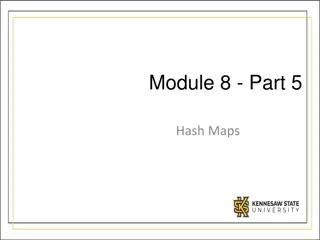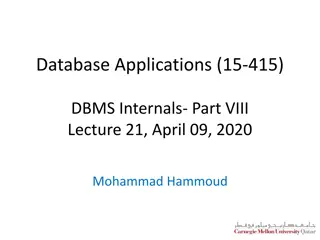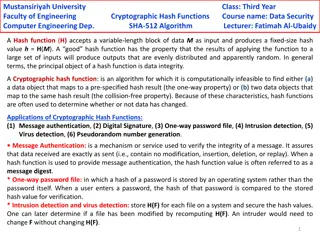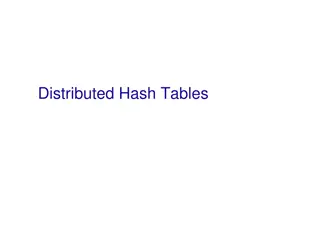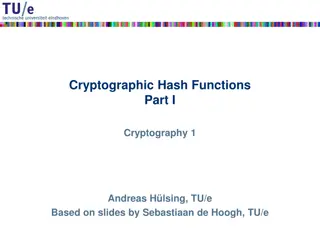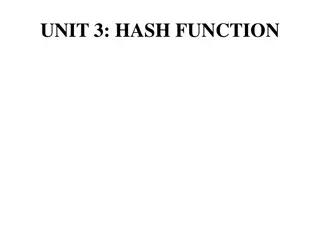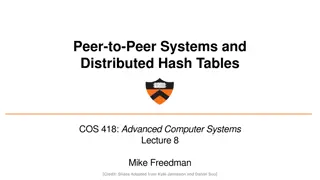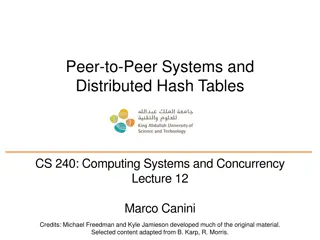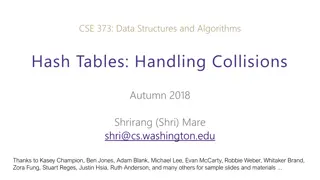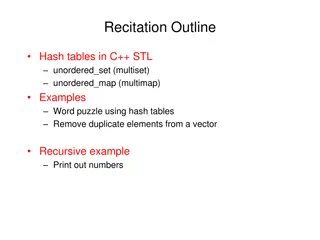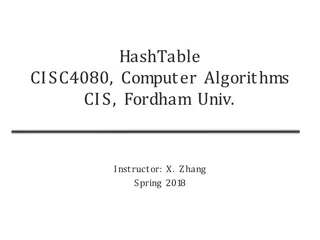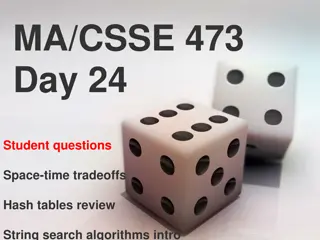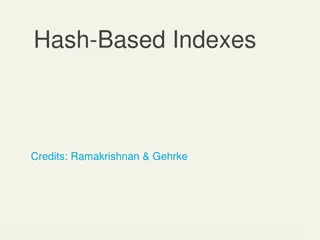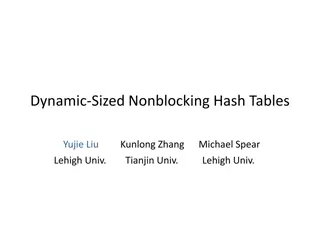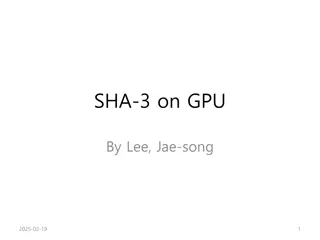
Hash Tables for Efficient Data Retrieval
Learn about hash tables and how they are used to efficiently retrieve data based on keys. Discover the implementation of dictionaries/maps, the role of hash functions, and the advantages of hash tables over other data structures. Dive into the concepts behind balanced BSTs and explore the potential of achieving O(1) access time with hash tables.
Download Presentation

Please find below an Image/Link to download the presentation.
The content on the website is provided AS IS for your information and personal use only. It may not be sold, licensed, or shared on other websites without obtaining consent from the author. If you encounter any issues during the download, it is possible that the publisher has removed the file from their server.
You are allowed to download the files provided on this website for personal or commercial use, subject to the condition that they are used lawfully. All files are the property of their respective owners.
The content on the website is provided AS IS for your information and personal use only. It may not be sold, licensed, or shared on other websites without obtaining consent from the author.
E N D
Presentation Transcript
1 CSCI 104 Hash Tables Mark Redekopp David Kempe Sandra Batista Aaron Cote
2 Motivation Suppose a company has a unique 3-digit ID for each of its 1000 employees. We want a data structure that, when given an employee ID, efficiently brings up that employee s record. How should we implement this? An array gives O(1) access time! Alright, how do we obtain this runtime when the keys are no longer so nicely ordered??
3 Dictionaries/Maps 2 An array maps integers to values Given i, array[i] returns the value in O(1) Dictionaries map keys to values Given key, k, map[k] returns the associated value Key can be anything provided It has a '<' operator defined for it (C++ map) or some other comparator functor Most languages implementation of a dictionary implementation require something similar to operator< for key types 0 1 2 3 4 5 3.2 2.7 3.452.91 3.8 4.0 3.45 Arrays associate an integer with some arbitrary type as the value (i.e. the key is always an integer) "Jill" map<string, double> "Tommy" 2.5 Pair<string,double> "Jill" 3.45 3.45 C++ maps allow any type to be the key
4 Dictionary Implementation A dictionary/map can be implemented with a balanced BST Insert, Find, Remove = O(______________) key value "Jordan" Student object "Frank" Student object "Percy" Student object "Anne" Student object "Greg" Student object "Tommy" Student object
5 Dictionary Implementation A dictionary/map can be implemented with a balanced BST Insert, Find, Remove = O(log2n) Can we do better? Hash tables (unordered maps) offer the promise of O(1) access time key value "Jordan" Student object "Frank" Student object "Percy" Student object "Anne" Student object "Greg" Student object "Tommy" Student object
6 Unordered_Maps / Hash Tables Can we use non-integer keys but still use an array? What if we just convert the non-integer key to an integer. For now, make the unrealistic assumption that each unique key converts to a unique integer This is the idea behind a hash table The conversion function is known as a hash function, h(k) It should be fast/easy to compute (O(x), where x is the length of the key) It should consistently output the same thing when given the same input. It should distribute keys well We d like every key to go to a different index, but that turns out to be almost impossible . "Jill" Conversion function 2 0 1 2 3 4 5 Bo 3.2 Tom 2.7 Jill 3.45 Tim 3.8 Lee 4.0 - 3.45
7 Unordered_Maps / Hash Tables A hash table implements a map ADT Add(key,value) Remove(key) Lookup/Find(key) : returns value In a BST the keys are kept in order A Binary Search Tree implements an ORDERED MAP In a hash table keys are evenly distributed throughout the table (unordered) A hash table implements an UNORDERED MAP "Jill" Conversion function 2 0 1 2 3 4 5 Bo 3.2 Tom 2.7 Jill 3.45 Tim 3.8 Lee 4.0 - 3.45
24 8 C++11 Implementation C++11 added new container classes: unordered_map unordered_set Each uses a hash table for average complexity to insert , erase, and find in O(1) Must compile with the -std=c++11 option in g++
9 Hash Tables A hash table is an array that stores key,value pairs Usually smaller than the size of possible set of keys, |S| USC ID's = 1010 options But larger than the expected number of keys to be entered (defined as n) The table is coupled with a function, h(k), that maps keys to an integer in the range [0..tableSize-1] (i.e. [0 to m-1]) What are the considerations How big should the table be? How to select a hash function? What if two keys map to the same array location? (i.e. h(k1) == h(k2) ) Known as a collision The probability of this should be low. key key, value 0 1 2 3 4 h(k) tableSize-2 tableSize-1 m = tableSize n = # of keys entered
10 Hash Tables are Awesome! Hash Tables provide a very lucrative potential runtime. However, they are probabilistic. There was a similar problem with Splay Trees: they had a good average runtime, but a poor worst-case runtime. As of this moment, we do not have the necessary mathematical framework to analyze either of these structures. We re going to start remedying that now.

